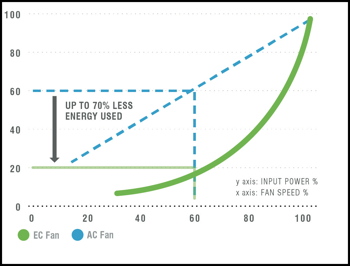Think EC for easy energy savings

As a simple and cost-effective retrofit with a short payback, replacing fans having AC motors with fans having EC motors is hard to beat — As Adrian Trevelyan explains.
For many businesses, a 20% reduction in energy costs represents the same bottom line benefit as a 5% increase in sales — according to The Carbon Trust. However, reducing energy consumption in a building on an ever decreasing budget is one of the biggest challenges for facility and energy managers like you today.
It is, in fact, HVAC equipment that accounts for the single largest proportion (39%) of energy consumption in a commercial building, owing to its use of numerous fan motors to move air throughout a building.
But you don’t need a complete retrofit or replacement of a system to reduce energy consumption and maintenance costs. Listed below are five benefits of why simply switching to EC (electrically commutated) fans in HVAC units will improve efficiencies and cut costs.
1.Up to 70% potential energy saving
EC fans offer the same output as AC fans for less input. This is because they are more than 90% efficient in converting electrical input into air movement. As a result, they consume up to 70% less energy compared to AC technology (diagram and table ). It has been shown that payback periods can be as little as 12 months and that replacing just four AC fans can provide annual cost savings of £7000.
| customer | units/fans | energy saved | energy saved | cost savings | CO2 reduction |
| BAE Warton | 68/125 | 2 231 002 kWh | 73% | £345 204 | 416 t |
| Marsh Data | 17/331 | 674 345 kWh | 60% | £98 287 | 84 t |
| Victoria & Albert Museum | 4/4 | 47 304 kWh | 60% | £7358 | 862 t |
| Virgin Media, Bromley | 2/2 | 31 536 kWh | 62% | £3153 | 16 t |
2.Variable-speed control matched to load requirement
AC fans are designed to operate at a certain point on their performance curve which coincides with their peak efficiency. Either side of this operating point, the efficiency can drop off considerably. EC fans on the other hand have an almost flat efficiency curve, which varies relatively little across the speed range. This makes the EC fan able to adjust to the level of cooling needed at the time, thereby cutting down energy wastage from fans running faster than necessary.
3.Direct-drive motors for maintenance-free operation
EC fans are maintenance free for three key reasons. First, the direction and speed of the motor are controlled electronically. Traditional fan motors, on the other hand, typically rely on carbon brushes to commutate the motors, and these have to be frequently changed as dust from the carbon brushes clogs up the filters.

Secondly, the high efficiency of EC fans means low motor temperature, dramatically reducing the amount of unwanted heat produced. Low motor temperature also improves the life of highly loaded motor parts like windings and bearings.
And thirdly, varied start-up speeds on EC fans reduce stress on mounting hardware and, therefore, wear and tear.
4.Reduction in noise levels; no acoustic enclosures required
With speed-controlled AC fans, noise levels spike in line with the voltage frequency. In contrast, EC fans offer quiet operation even at a low rotational speed. This is especially relevant for noise sensitive applications such as supermarkets in residential areas, where the use of EC fans can negate the additional requirement and cost of acoustic enclosures.
5.Easy connection and low set-up costs
EC fans contain compact motors, which makes them fully interchangeable with AC products for retrofit. Also EC fans require very little configuration. so no complicated wiring or set-up with a frequency controller is required.
With a payback period of two years or less, and the upgrade procedure resulting in minimal disruption, switching to EC fans is one of the easiest and most effective ways for you to cut HVAC energy costs.
Adrian Trevelyan is service manager with Airedale International Air Conditioning.
For more information please visit the link below or search for ‘airedale ec fan energy upgrades’







